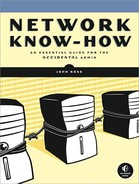This is a book about computer networks rather than home improvement or new home construction, so it's not the place to describe all the special tools and techniques that electricians and telephone installers have been using for more than a hundred years to push wires through walls, under moldings, and inside closets. If you plan to install your own internal wiring, consult some of the do-it-yourself websites or look for a book about home wiring at your local home center before you start.
Note
I can specifically recommend Wiring Home Networks (Sunset Books, 2004) as a guide to installing network wiring, because I wrote it. However, several other illustrated books about home wiring also include the information you need.
In order to feed wires from wall plates or surface boxes through your walls to the control center, you will have to drill some holes through base plates, studs, and other structural elements of your house or workplace. If you're working in rooms on the ground floor, you might be able to reach the spaces between the walls from below, drilling upward from an unfinished ceiling in the basement or crawl space. On the top floor, you can work downward from the attic. But if you can't get to the inside of the walls from above or below, your best option will be to cut holes in the wall and drill through the vertical studs, or to hide cables and holes behind mop boards and other moldings. After the wires are in place, you'll have to patch the holes and repaint the walls.
Use an electrician's snake to pull or push cables through places that you can't reach with your hands. When the end of the snake reaches the target location, attach the end of the bulk cable to the snake with electrical tape and pull the snake and cable back from the other end. It's a lot easier to route wires with a rigid snake (a long, thin piece of metal) than to deal with loose cable flopping around inside a wall.
Remember to add a length of heavy twine as a pull line along with each cable or cable bundle that you pull through the walls. In the future, when you want to add another cable along the same route, you can attach the cable to the pull line and pull it through without the need to create new holes in your walls.
You're going to connect a lot of cables to and through the control center, so you will want to keep them out of sight in order to maintain a neat and clean appearance. A 2-inch PVC pipe at the back of a closet or in some other hidden location can provide an inconspicuous route for cables between an upper floor or the attic and the basement or crawl space. If the pipe runs through the space where the control center is located, assemble a channel from two shorter pipes and a tee fitting about four or five feet above the floor. Pipes, fittings, and glue are all available at your local hardware store or home center.
